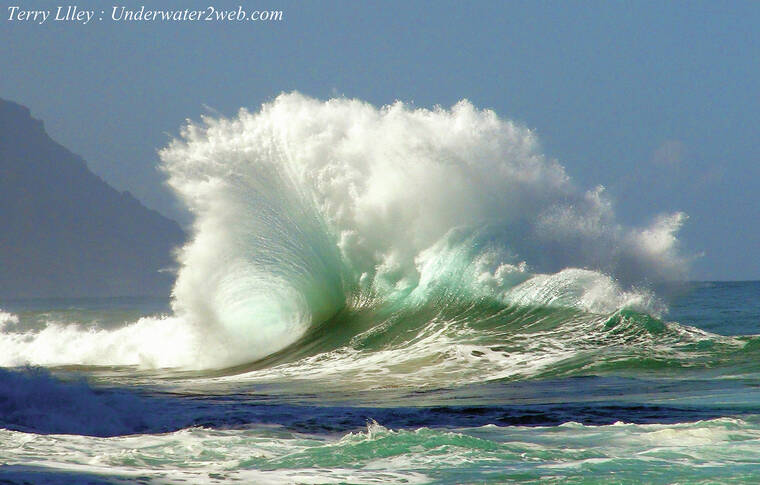I was out diving at Sharks Cove in O‘ahu a few days before Thanksgiving and there were clouds of fish in the marine reserve.
Hundreds of different species from parrotfish to huge school of convict tangs feeding normally out on the reef.
Most of the fish were in depths from about 5 feet to 30 feet deep and the water was nice and clear. Just another normal day diving at Sharks Cove.
Being a surfer and diver I always pay attention to the surf report, which can predict incoming swells out about five to eight days accurately. The surf report showed that a huge 40-foot swell was to hit Hawai‘i the day after Thanksgiving.
I immediately started thinking about the huge schools of fish at Sharks Cove, wondering where they go when the surf comes up. A 40-foot wave can rip a live coral right off of the reef at 30 feet deep and can roll around 300 pound rocks on the reef so where do all of the delicate small fish go to keep from being washed away in the giant surf?
Out of curiosity I went out snorkeling the day before the huge swell was to hit and sure enough the large schools of fish were gone. Did they somehow know a huge swell was on its way? The reef looked like a ghost town, but there were still some small fish right up in the shallow water.
I have observed large schools of fish like the convict tangs (manini) that separate from their school at night to sleep by themselves in holes in the reef. Maybe the fish were starting to hide in holes and caves in the reef before the big surf came in.
Waves in Hawai‘i can come up very quickly due to the deep water offshore. The surf can go from 3 feet to 30 feet in just one day and the reef fish must know this is going to happen because I see them back in shallow water a few days after a big swell and they look just fine.
Our lava reefs are filled with holes and caves, and maybe some of the fish go back into the caves to avoid being smashed by the big waves but some of our reefs are flat and solid and lack any caves.
It is possible that some of our reef fish go out into deep water when the surf comes up. We have many species of fish that are only known to live in shallow water, but we can’t go observe them during a big swell so they may go into deep water to avoid the surf.
We do know that some of our common reef fish like the nenue (chub) have large schools of adult fish in shallow water, but we never see their babies.
Do they go into deep water to reproduce? Some species of wrasse only have the females in shallow water and most divers have never seen a male.
Do the males live in deep water and the females go visit them from time to time? We just don’t know.
The lives of our Hawaiian reef fish are still a mystery because they are hard to observe out in the sea when the conditions are rough.
With underwater unmanned deep sea rovers, we are now being able to see what fish species live at a 1,000 feet deep and it turns out that some of the common shallow water species are found in deep water from time to time. We have deep water video of the knifejaw fish at 1,000 feet deep and I have also shot video of this fish in shallow water.
We may think that we know a lot about our local reef fish, but we actually know very little. We don’t know where they go at night to sleep, where they breed or where they go when the surf gets huge. Maybe down the road we will have tiny “critter cams” we can attach to the fish to track them like we currently do with sea turtles, dolphin and monk seals.
You can see many of the common reef fish in my documentary movie about Sharks Cove up on my website at www.underwater2web.com. In the video, I show the dive site when the waves are 40 feet and it makes you wonder how the fish can live through that kind of dramatic change to their home.
•••
Terry Lilley is a marine biologist living in Hanalei Kaua‘i and co-founder of Reef Guardians Hawai‘i, a nonprofit on a mission to provide education and resources to protect the coral reef. To donate to Reef Guardians Hawaii go to www.reefguardianshawaii.org.


